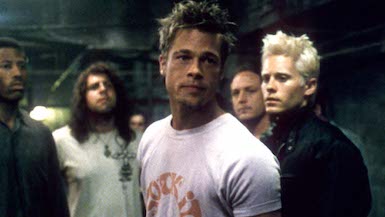The Number One Movie in America: Fight Club
By Sean Collier
June 18, 2021
BoxOfficeProphets.com

Settle down, superfans — this isn’t some retroactive hit on David Fincher’s near-masterpiece. I’m a fan. It’s true, though; almost no one bought a ticket to see “Fight Club.”
It won exactly one weekend, and only just. The now-classic satire debuted Oct. 15, 1999, and earned a humble $11 million in its first frame; that nudged it into the top spot over the defending three-week champion, the Ashley Judd thriller “Double Jeopardy.” Had Judd snared another $800,000 or so, “Fight Club” would never have been a box-office champion.
After that, it didn’t even put up a ... fight. (Sorry.) Project Mayhem settled for third place in its sophomore weekend, dropping the crown to “The Best Man” and, yes, dipping below “Double Jeopardy,” by then in its fifth weekend.
Just over a month after release, “Fight Club” was all the way out of the top 10. It limped to a domestic toal just past the $37 million mark. It’s the 54th overall earner for 1999. “Bowfinger” made more than “Fight Club.” So did “Stigmata.” And “Anna and the King.” And “Forces of Nature.”
So: How did “Fight Club,” y’know, become “Fight Club,” particularly after such a tepid response?
In short: Nearly everyone who bought a shiny, new DVD player immediately went to Blockbuster and rented it. (And “Austin Powers,” but that’s another matter.)
“Fight Club” was reported to have earned $60 million in rental fees — and a little envelope math there reveals how impressive that is. Figure a $5 rental (which is being generous), and that’s at least 12 million individual rentals. Another 6 million people bought a copy of the film during its first 10 years of home release, thanks to several expansive packages overseen and designed by Fincher himself.
The “Fight Club” experience, then, has next to nothing to do with seeing this movie on the big screen. It has everything to do with seeing it on a boxy, 15-inch screen in your dorm room.
That explosion of home-viewing interest may have been a blessing and a curse. “Fight Club” became a cult staple with young men, many of whom firmly missed the point. Packaged inside a action-mystery-comedy, Fincher’s film is a full-throated indictment of masculinity, particularly the type that sprouts in all-male environments. (How many frat houses do you think gathered to watch the film, had a few beers and then decided to go a few rounds in the basement?) Its mysterious pseudo-protagonist, Tyler Durden, is the subject of the film’s ire and derision; any close viewing at all reveals that his dime-store philosophy is preposterous. There’s no coherent structure to his musings.
Yet Durden became something of an antihero. (If “Fight Club” has a significant flaw, it’s making Durden so cool and funny — a project helped considerably by the face and body of Brad Pitt — that aspirational viewers might’ve missed that he was a monster.) When he gets around to coining, or at least popularizing, the term “snowflake,” in a speech that was promptly taken literally rather than as the nihilistic gobbledygook that it is, you realize that this movie landed exactly the wrong way for a lot of people.
That’s part of the meta-narrative, though; let’s not get away from the fact that “Fight Club” is awesome. Smart, funny, entertaining, daring, sexy — when someone tells you that “Fight Club” is their favorite movie, you don’t blink. It’s worthy of adulation and, 22 years later, status as a pillar of cinema.
Even if a lot of people missed the point. Maybe they should’ve followed the first two rules.
“Fight Club” is the subject of the latest episode of The Number One Movie in America, a look back at past box-office champions. Each episode’s film is drawn at random from a list of every number-one movie since 1977. Please listen and subscribe!
Next time: Are Sundays for church, or kicking off your day-appropriate shoes?